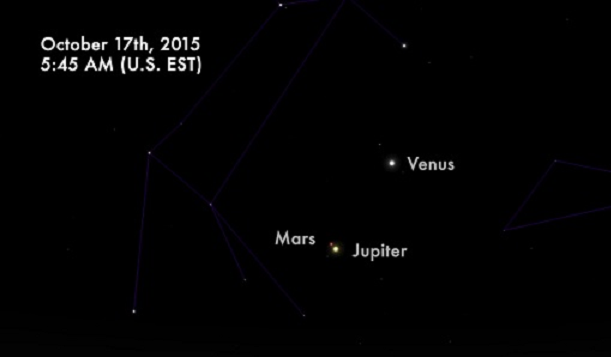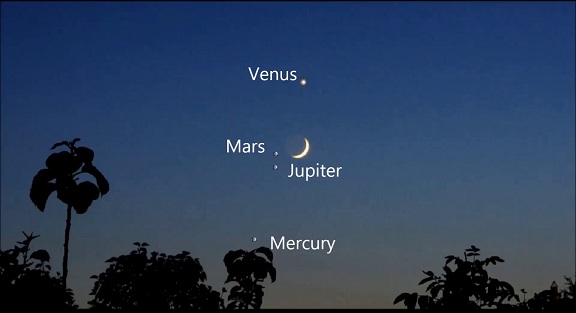| Online: | |
| Visits: | |
| Stories: |

| Story Views | |
| Now: | |
| Last Hour: | |
| Last 24 Hours: | |
| Total: | |
Top Night Sky Event: Rare Astronomical Coincidence of a Spectacular Triangular Triple Conjunction of 3 Bright Planets (+Video)
Top Night Sky Event. Rare Spectacular Triple Planet Conjunction.

Looking East before sunrise,
The rare astronomical coincidence of a spectacular triangular triple conjunction of 3 bright planets is certainly wowing the entire World of Earthlings.
Triple planetary conjunctions are a rather rare occurrence. The last one took place in May 26th 2013.
Before sunrise our Solar System’s two brightest planets – Venus and Jupiter – as well as Mars are very closely aligned for about two weeks.
Starting on 17th of October 2015 and continuing throughout the end of this month.
Well you’re are in for a celestial treat. The conjunction is visible to the naked eye – look East before sunrise. No telescopes or binoculars needed.
Throughout October, the trio of wandering planets have been gradually gathering closer and closer.
Saturn hangs low over the southwestern horizon after sunset
Try to catch a view of Saturn’s rings in a telescope before the planet sets.
Pegasus, the great winged horse of Greek mythology prances across the autumn night sky
His body is denoted by a large area of stars known as the Great Square.
Pegasus hosts 51 Pegasi the first sun like star known to have an extrasolar planet
The brightest corner of the Great Square, Alpheratz is also the brightest star in the constellation Andromeda
In Greek mythology this princess was chained to a rock near the sea to appease a sea monster
Within Andromeda’s boundaries look for M31
the Andromeda galaxy, an island of billions of stars
On a clear dark night it appears as a faint smog of light
approximately 2.5 million light years away M31 is the closest spiral galaxy to our own Milky Way galaxy and the most distant object you can see with your eyes alone
binoculars and small telescopes reveal M31′s blowing nucleus and spiral arms
a smaller companion galaxy M110 appears as a fade spot near the large galaxy
The Andromeda galaxy is slowly pulling in and will eventually consume another one small companion galaxy M32
An interesting meteor shower peaks on the night of October 21st to 22nd.
After midnight look to the east where the constellation Orion is rising. Every few minutes you may spy a tiny remnant of Halley’s comet burning up high in the atmosphere.
This is the Orionid meteor shower.
The best time to view the Orionids is just after midnight and right before dusk.
It’s called Orionids because the meteors seem to emerge or radiate from the constellation Orion.
A first quarter Moon will make this meteor shower easy to see in both the Northern and Southern Hemisphere.
The Orionid meteor shower is one of two meteor showers created by debris from Comet Halley.
Halley takes around 76 years to make a complete revolution around the Sun. It will next be visible from Earth in 2061. http://www.timeanddate.com/astronomy/meteor-shower/orionid.html

October 8, 2015 before sunrise



